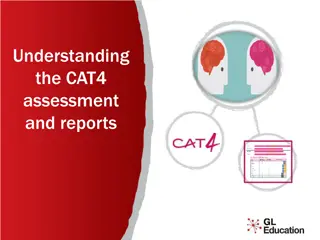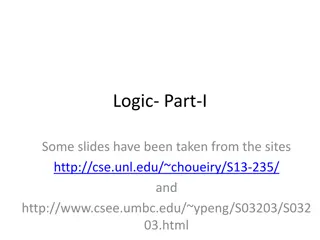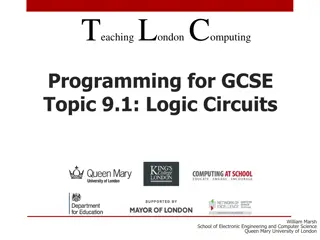Understanding Truth-Table Analysis in Logic and Critical Reasoning
A truth-table is a table used in logic to show the distribution of truth values over compound formulas. It helps determine the truth values of formulas based on fixed inputs and truth functions. By following rules for constructing a truth-table and distributing basic truth values in rows, logicians can analyze and evaluate logical statements effectively.
Download Presentation

Please find below an Image/Link to download the presentation.
The content on the website is provided AS IS for your information and personal use only. It may not be sold, licensed, or shared on other websites without obtaining consent from the author. Download presentation by click this link. If you encounter any issues during the download, it is possible that the publisher has removed the file from their server.
E N D
Presentation Transcript
Logic & Critical Reasoning Truth-Table Analysis
What is a Truth-Table A truth-table is a table that shows the distribution of truth-values, T and F, over a set of compound formulas. The distribution is determined by a fixed set of truth- values as inputs, the definitions of the truth functions involved in the compound formulas, and the determination of dependency. The fixed set of inputs are under P and Q at the left. The final value of the formula is under the main connective in bold. Computation goes from P Q (P Q) T T T F F T F F (Q P) T T F T T F T F T F F F subordinate operators to the main connective
Rules for Constructing a Truth-Table The number of rows that a truth-table needs is determined by the number of basic statement letters involved in the set of formulas that will be involved in the computation. The formula for the rows is 2nwhere n = the number of basic statement letters involved. The most common instances are where n = 1, 2, and 3; in those cases one needs 2, 4, and 8 rows respectively. The number of columns that a truth-table needs is determined by the number of basic statement letters and formulas involved. There should be one column for each basic statement letter and formula. For each formula the computation proceeds from weakest scope to widest scope. The operation in the widest scope is computed last. And if two sub-formulas of a a formula have no greater weight in scope, then it does not matter which one is computed first.
Distributing Basic Truth-Values in the Rows A truth-table is a computation based on an initial set of input truth-values. These values are fixed. The number of basic rows is given by the number of basic statement letters, each of which can be either true or false. Thus, in making a truth- table, one needs to account for every possible combination of how T and F can be distributed amongst the basic statement letters prior to computing the compound cases via the definition. The easiest way to make sure all possible distributions of T and F have been accounted for, one can use the procedure of halving and alternating Ts and Fs, explained by the case in which one has 3 basic statement letters, P, Q, and R, and thus 8 rows, by the formula 2n. Set the first column under P to 4Ts, followed by 4Fs. Set the second column under Q to 2Ts, 2Fs, 2Ts, 2Fs Set the third column under R to 1T, 1F, 1T, 1F, 1T, 1F, 1T, 1F
The Case of Eight Rows Since the formula has 3 basic statement letters, we need 8 rows, following the procedure we have every possible combination of T and F that applies to P, Q, and R. (P ( Q R) P T T T T F F F F Q R T T F F T T F F T F T F T F T F
What can a truth-table be used for? A truth-table can be used to determine the answer to a number of questions that logicians care about. Where and are arbitrary formulas of PL, a truth-table can be used to answer any of the following questions: Is a tautology, contingent, or a contradiction? Are and logically consistent or inconsistent? Are and logically equivalent? Is a valid consequence of ?
Definitions of Key Logical Concepts Let the truth-profile of a formula be the column underneath the main connective of the formula. Logical Concept Representation on a Truth-Table Tautology The truth-profile is all T. Contingent The truth-profile is some T, and some F. Contradiction The truth-profile is all F. Consistent At least one row has T in the truth-profile for all formulas involved. Inconsistent There is no row that has T in the truth-profile for all formulas involved. Equivalent The truth-profiles are identical for all formulas involved. Valid There is no row where the truth-profile for all the premises has a T, and the the truth-profile for the conclusion has an F. Invalid There is some row where the truth-profile for all the premises has a T, and the truth-profile for the conclusion has an F.
Examples: Tautology A statement or formula is a tautology when it is always true. On a truth- table this means that the truth-profile contains only Ts. (P (Q P)) T T T T P T T F F Q T F T F T T F T
Examples: Contingent A statement or formula is contingent when it is true sometimes, and false other times. On a truth-table this means that the truth-profile contains some Ts and some Fs. (P Q) T T F T P T T F F Q T F T F F T F T
Examples: Contradiction A statement or formula is a contradiction when it is always false. On a truth-table this means that the truth-profile contains only Fs. (P P) F F P T F F T
Examples: Consistency Two or more statements or formulas are consistent when they can be true at the same time. On a truth-table this means that there is at least one row where there is a T in the truth-profile of each formula involved. (P Q) T F F F (P Q) T T T F P T T T F F Q F T F
Examples: Inconsistency Two or more statements or formulas are inconsistent when they can never be true at the same time. On a truth-table this means that there is no row where there is a T in the truth-profile of all of the formulas involved. (P Q) F T F F ( P Q) F T T F F T T T P T T T F F F Q T F T T T F
Examples: Equivalence Two or more statements or formulas are logically equivalent when they mean the same thing from the point of view of logic. On a truth-table this means that the the truth-profile of all the formulas involved is identical. (P Q) T F T F ( P Q) T F T T P T T F F Q T F T T F T F F F T F T
Examples: Validity An argument is valid when it is impossible for the premises to be true and the conclusion false. On a truth-table this means that there is no row where there is a T in the truth-profile of each premise, and an F in the truth-profile of the conclusion. Let (P Q) and P be the premises, and Q the conclusion (P Q) T F T F P T T F F Q T F T F P Q T T T F F F ok ok ok ok T F
Examples: Invalidity An argument is invalid when it is possible for the premises to be true and the conclusion false. On a truth-table this means that there is at least one row where there is a T in the truth-profile of each premise, and an F in the truth-profile of the conclusion. Let (P Q) and P be the premises, and Q the conclusion (P Q) T T T T P T T T F F F Q P T T F F Q T F T F ok !!!!! ok ok T F























